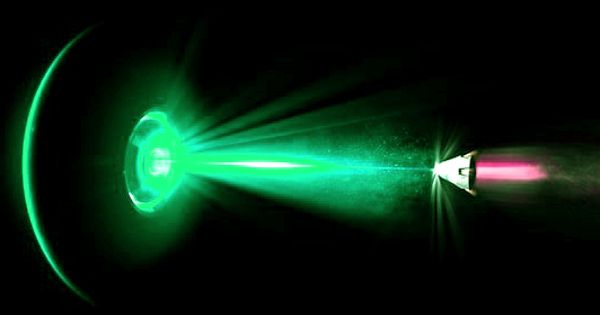Extreme states can be found at the cores of planets: temperatures in the thousands of degrees Celsius, pressures a million times greater than atmospheric pressure. As a result, they can only be explored directly to a limited extent, which is why the expert community is attempting to recreate equivalent extreme conditions using sophisticated experiments.
An international research team led by the Helmholtz-Zentrum Dresden-Rossendorf (HZDR) successfully adapted and tested an established measurement method to these extreme conditions: The team was able to take a closer look at the important element, carbon, as well as its chemical properties, by using the light flashes of the world’s strongest X-ray laser. According to the journal Physics of Plasmas, the method now has the potential to provide new insights into the interiors of planets both inside and outside our solar system.
The heat is unbearable, and the pressure is enormous: The conditions in Jupiter’s or Saturn’s interior ensure that the matter found there is in an unusual state: it is as dense as metal but electrically charged like plasma. “We call this state warm dense matter,” Dominik Kraus, a physicist at HZDR and professor at the University of Rostock, explains. “It is a transitional state between solid and plasma found in the interiors of planets, but it can also occur briefly on Earth, for example, during meteor impacts.”
Examining this state of matter in detail in the lab is a complicated process that involves, for example, firing strong laser flashes at a sample and heating and condensing it in the blink of an eye.
Researchers adapted an established measurement method to extreme conditions and tested these conditions successfully: Using the light flashes of the world’s strongest X-ray laser the team managed to take a closer look at the important element, carbon, along with its chemical properties.
But what exactly are the chemical properties of this warm dense matter? Existing methods have only yielded unsatisfactory answers to this question so far. So, a team of six countries devised a new method based on the world’s most powerful X-ray laser, the European XFEL in Hamburg. Extremely short, intense X-ray pulses are generated in a kilometer-long accelerator.
“We targeted thin carbon foils with the pulses,” says lead author Katja Voigt of HZDR’s Institute of Radiation Physics. “They were made of diamonds or graphite.” A small portion of the X-ray flashes in the foils are scattered on electrons and their surroundings. The important thing is that the scattered flashes can reveal the type of chemical bond formed by the carbon atoms with their surroundings.

After the doubts came to the surprise
This method, known as X-ray Raman scattering, has long been used by researchers in fields such as materials science. However, for the first time, the team led by Voigt and Kraus was able to outfit it for experiments probing the warm dense matter. “Some experts were skeptical that it could work,” Kraus says. The detectors, in particular, that must capture the X-ray signals emitted by the carbon foils, must be both highly efficient and high-resolution, which presents a significant technical challenge. However, an examination of the measurement data revealed which bonding states the carbon had entered.
“We were a little surprised that it worked so well,” Voigt says, clearly pleased. However, if they were to use the method to warm dense matter, something was still missing: powerful laser flashes that would drive the carbon foils to high pressures and temperatures of up to several hundred thousand degrees. The Helmholtz International Beamline for Extreme Fields (HIBEF), which was recently inaugurated at the European XFEL under the auspices of HZDR, comes into play for this purpose. It is one of the most advanced research facilities in the world, with high-performance lasers capable of performing the first X-ray Raman experiments in a matter of months. “I’m really optimistic that it’ll work,” says Dominik Kraus.
Comet crash in the lab
For example, it is unknown how many light elements, such as carbon or silicon, exist in the Earth’s core. Experiments in the lab could yield significant results. “The new method is not limited to carbon, but it could be applied to other light elements,” Katja Voigt says. Another question to be investigated concerns the interiors of so-called gas giants such as Jupiter and ice giants such as Neptune.
Complex chemical reactions will take place here, just as they do on distant exoplanets of comparable size. These processes should be able to be replicated in the lab using the X-ray Raman method. “Perhaps it will be possible to solve the puzzle of which reactions cause planets like Neptune and Saturn to emit more energy than they should,” Kraus hopes.
Furthermore, this new method should allow scientists to simulate comet collisions on a small scale: If comets did once transport organic matter to Earth, could the collision have triggered chemical reactions that favored the development of life? Furthermore, the method has the potential for technical applications: In principle, it appears possible that novel materials with fascinating properties could form under extreme conditions.
A superconductor that operates at room temperature and does not require complicated cooling, as do existing materials, is one example. A room-temperature superconductor of this type would be of great technological interest because it could conduct electricity completely losslessly without the need for liquid nitrogen or liquid helium cooling.
















